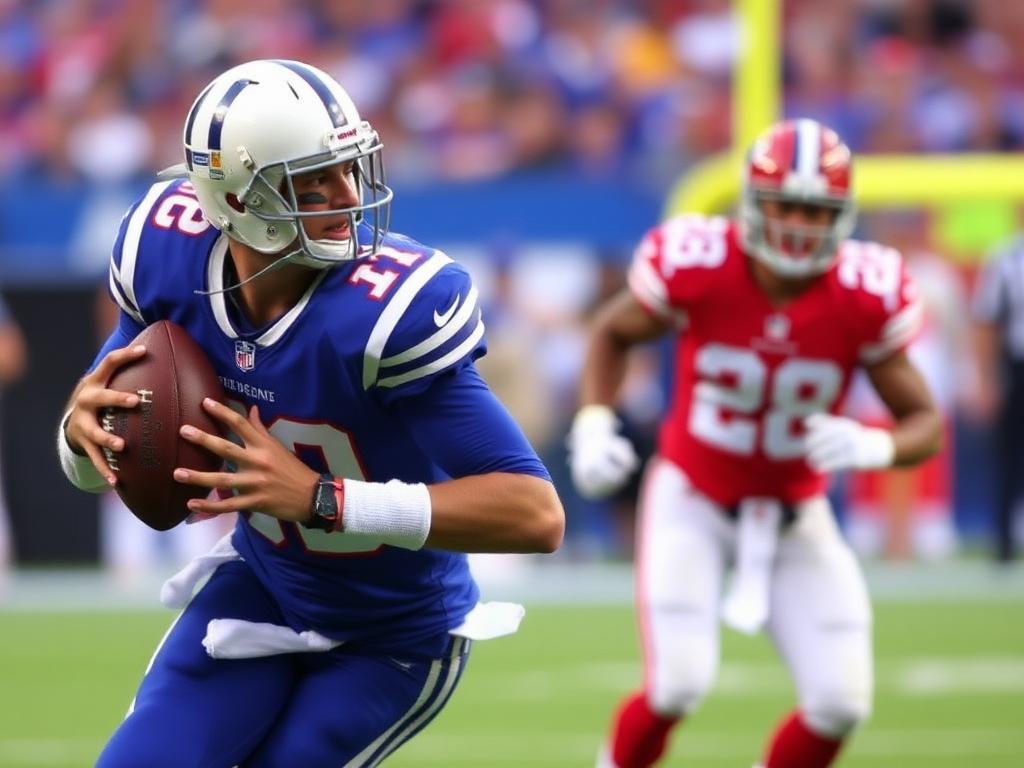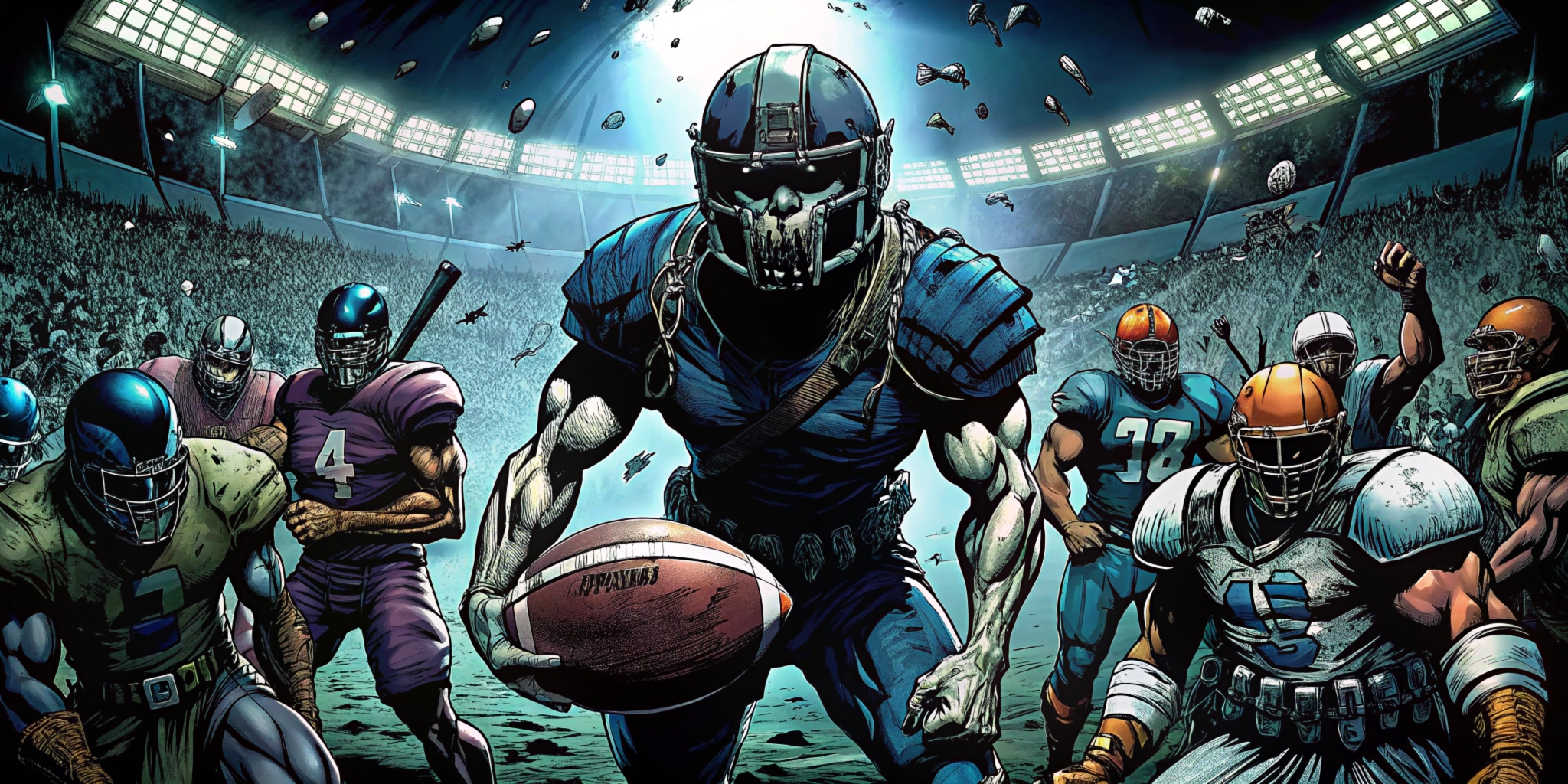Fantasy football is an exciting game that lets fans act as team managers. Instead of just watching their favorite players on TV, participants draft real NFL players to create their own teams. Points are earned based on how well these players perform in actual games. This makes every pass, touchdown, and yard gained even more thrilling to follow.
Over the years, fantasy football has grown in popularity, with millions of people worldwide joining leagues. Whether you’re playing for fun, bragging rights, or money, the competition is fierce. To succeed, it’s not just about luck—having the right rankings and strategies can make all the difference. Rankings help identify the best players, while strategies guide decisions like drafting, trading, and setting lineups.
Preparation is the ultimate secret weapon. A well-prepared manager knows which players to target and how to navigate the ups and downs of the season. Without a plan, it’s easy to fall behind. But with the right knowledge, you can dominate your league and enjoy the thrill of victory. Are you ready to take your fantasy football skills to the next level? Let’s dive in!
Understanding Fantasy Football Rankings
Fantasy football rankings are the backbone of every successful team. They act as a guide to help managers decide which players to draft, trade, or start each week. These rankings are based on various factors, including player stats, team dynamics, and upcoming matchups. A solid understanding of rankings can turn a casual player into a serious contender. By relying on rankings, managers can avoid guesswork and make smarter decisions that lead to more wins.
What Are Fantasy Football Rankings?
Fantasy football rankings list players in order of their projected performance. They are essential because they help managers identify the best players for their teams. Rankings simplify complex data, giving a clear picture of which players are worth targeting.
Experts create rankings by analyzing a mix of factors: past performance, team roles, injury risks, and even coaching styles. For example, a running back who gets a lot of touches in a strong offense will rank higher than one in a weaker team. Rankings also account for the type of league you’re in, like standard or PPR formats. Ultimately, they serve as a roadmap to help you draft and manage your team confidently.
Types of Rankings
There are several ranking types to explore in modern Fantasy football.
Standard Rankings
Standard rankings focus on players who excel in traditional scoring leagues. Points are awarded for touchdowns, rushing yards, passing yards, and receptions. In these leagues, running backs and wide receivers tend to dominate because they often contribute the most to scoring. Standard rankings prioritize consistent, high-scoring players who can deliver points each week.
For example, in a standard league, a running back who frequently scores touchdowns will rank higher than one who primarily gains yards without scoring. These rankings are perfect for leagues that stick to basic scoring rules without bonuses for extra stats like receptions. They help managers focus on the core contributors to their team’s success, making them a popular choice for beginners.
PPR Rankings
PPR (Points Per Reception) rankings adjust player values for leagues that reward a point for each reception. In these leagues, wide receivers and pass-catching running backs become more valuable. Players who may not score many touchdowns but catch a lot of passes, like slot receivers, move up the rankings.
For example, a player like Christian McCaffrey, who excels in both rushing and receiving, would rank higher in PPR than in standard leagues. PPR rankings shift the focus to players who excel in catching the ball, making them essential for leagues with this scoring format.
Dynasty Rankings
Dynasty rankings are tailored for leagues where managers keep most or all of their players from season to season. These rankings emphasize long-term value, focusing on younger players and those with career stability.
For instance, rookies and young stars like Ja’Marr Chase or Justin Jefferson might rank higher because they have many years of productivity ahead. Aging stars, while still productive, may drop in dynasty rankings due to their limited remaining playing years.
Positional Rankings
Positional rankings break down players based on their role, such as quarterback (QB), running back (RB), wide receiver (WR), and tight end (TE). This helps managers identify the best players in each category, ensuring a well-rounded team.
For example, a top-tier quarterback like Patrick Mahomes may be the highest-ranked QB, but when compared to a star running back, he may rank lower overall due to positional scarcity. Positional rankings are useful for balancing your draft strategy and ensuring you fill key roles effectively.
Factors Influencing Player Rankings
Player rankings are influenced by several key factors:
- Player Performance History: A track record of consistent scoring makes a player more reliable and valuable in rankings.
- Team Offensive Style: Teams with pass-heavy or run-heavy offenses directly impact the rankings of their key players.
- Injury History and Potential: Players with frequent injuries or a high risk of injury may rank lower, even if they are talented.
- Matchup and Strength of Schedule: A player facing weaker defenses or teams with poor defensive stats is often ranked higher for that week.
Conversely, players going up against tough defenses may see their rankings drop, even if they are usually reliable. Matchups are crucial for identifying breakout opportunities or avoiding underperforming players.
Other factors like weather conditions, coaching changes, and recent team dynamics also play a role. For example, bad weather could reduce passing opportunities, affecting quarterbacks and wide receivers. Coaches who favor certain play styles may elevate the value of specific players.
By considering these factors, managers can make smarter decisions. Rankings are not just numbers—they’re a reflection of current conditions and trends in football. This awareness helps fantasy managers adapt to changes and make informed choices that improve their chances of success.
Proven Strategies for Fantasy Football Success
Winning at fantasy football requires more than luck. Success stems from careful planning, smart decisions, and ongoing adjustments throughout the season. By using proven strategies, you can create a competitive edge that keeps you ahead of your league. Whether it’s researching before the draft or managing your roster during the season, every decision matters.
Understanding your league’s rules, scoring system, and player pool is the foundation of a strong strategy. From there, focus on drafting well-balanced teams and staying active in free agency. Preparation and flexibility are your greatest tools. Let’s dive into specific strategies to dominate every stage of the fantasy football season.
Pre-Draft Preparation
Preparation is crucial for drafting a winning team. Start by researching players and creating personalized rankings based on your league’s scoring format. This ensures you’re targeting players who will bring the most value to your specific team setup.
Mock drafts are an excellent way to practice. They help you test different draft strategies and see how player availability changes round by round. Use these to refine your approach and anticipate how other managers might draft.
Understanding your league’s rules and scoring system is equally important. Does your league reward points per reception (PPR), or is it a standard scoring system? Are there bonuses for big plays? These details can drastically influence player values.
By investing time in pre-draft preparation, you’ll enter the draft room confident and ready to build a powerhouse team.
Draft Day Tips
Draft day is where the foundation of your season is built. To start strong, prioritize creating a balanced roster. This means drafting players across all key positions, like quarterback, running back, wide receiver, and tight end. Avoid overloading one position early on.
High-value positions, such as running backs and wide receivers, should be targeted in the early rounds. These players often deliver the most consistent points, so locking in top-tier talent is vital.
Avoid falling into the trap of drafting players from your favorite team or relying on personal biases. Fantasy football is about performance, not fandom. Keeping emotions out of your draft decisions will help you build a stronger team.
Late-round picks can make or break your season. Look for sleepers—players with high potential who are undervalued by others. These gems often outperform their draft position and become key contributors.
Draft Tip Table
| Round | Focus | Example Players |
|---|---|---|
| Rounds 1-2 | Secure elite talent at RB or WR | Christian McCaffrey, Ja’Marr Chase |
| Rounds 3-5 | Target dependable starters at multiple positions | Patrick Mahomes, Mark Andrews |
| Rounds 6-10 | Add depth and upside players | James Cook, Brandon Aiyuk |
| Late Rounds | Look for sleepers and high-potential players | Zay Flowers, Tank Bigsby |
Drafting strategically ensures a solid foundation for your team while leaving room for growth and surprises.
In-Season Management
Fantasy football success depends on constant attention to your team during the season. Monitoring the waiver wire and free agency is one of the most critical aspects of in-season management. As the NFL season progresses, injuries, bye weeks, and breakout players will create opportunities to strengthen your roster. Staying active on the waiver wire ensures you’re not missing out on valuable contributors who can make a difference.
Trades can also elevate your team’s performance. Focus on trading up for better players or addressing weak spots in your lineup. Pay attention to trends, like a player whose performance is improving or declining, to make calculated moves. Offering fair trades that benefit both teams increases the likelihood of deals being accepted.
Weekly lineup optimization is where your knowledge of matchups comes into play. Analyzing which players face favorable defenses can give you a scoring edge. For example, starting a wide receiver against a team with a poor secondary can lead to big points. Conversely, benching players with tough matchups minimizes risk. Stay flexible and adjust your lineup based on the latest news and updates.
In-season management requires effort, but it’s the key to staying competitive, no matter how your draft played out.
Playoff Push and Championship Strategies
The fantasy football playoffs are the culmination of your season, and strategic moves during this phase can make or break your championship dreams. Preparing in advance with smart roster management is essential for success.
Start by identifying and stashing players with favorable matchups during playoff weeks. For example, a running back facing defenses like the Houston Texans or Arizona Cardinals, which have struggled against the run, could be a league-winner. Similarly, wide receivers playing against teams with weak secondaries, such as the Chicago Bears, are worth targeting. Planning your lineup around these matchups gives you a tactical edge over opponents.
Avoid chasing points from players who had one great game but don’t have a consistent role. For instance, if a backup running back like Tyjae Spears scored a touchdown in relief of Derrick Henry, confirm their workload before starting them. Consistency and opportunity should guide your decisions.
Injuries and rest days are especially critical during the fantasy playoffs. NFL teams bound for the playoffs, like the Kansas City Chiefs or San Francisco 49ers, often rest their star players in the final weeks. If you rely on players like Patrick Mahomes or Christian McCaffrey, monitor reports to ensure they’re playing. Stashing reliable backups like a solid second-string QB or RB can save your team in these scenarios.
Another strategy is to pay attention to waiver-wire defenses. For example, picking up a defense with favorable matchups, such as the New Orleans Saints against a struggling offense, can provide a significant points boost during playoff weeks.
Lastly, double-check your roster and make data-driven decisions. Avoid impulsive moves based on a single week’s stats. Trust the strategies and research that carried you to the playoffs. Staying calm, prepared, and flexible can help you secure your championship trophy.
Common Mistakes to Avoid
Fantasy football is as much about avoiding pitfalls as it is about making the right moves. Many managers make common errors that can derail their season. Here’s how to sidestep some of the biggest mistakes and keep your team competitive.
Overdrafting Quarterbacks
One of the most frequent mistakes in fantasy football is drafting a quarterback too early. While quarterbacks often score the most points, their position isn’t as valuable as it seems in the first few rounds. This is because running backs (RBs) and wide receivers (WRs) are harder to replace.
For example, top-tier RBs like Christian McCaffrey or WRs like Justin Jefferson touch the ball more often and have fewer quality replacements available later in the draft. In contrast, quarterbacks like Jalen Hurts and Patrick Mahomes are exceptional but can still be outscored or nearly matched by later-round options like Trevor Lawrence or Kirk Cousins.
Prioritizing RBs and WRs early in the draft allows you to build a strong foundation with consistent point-scorers. Waiting until the middle rounds to pick a quarterback gives you more roster flexibility and depth. Remember, depth wins championships.
Ignoring Bye Weeks and Depth
Another big mistake is overlooking bye weeks and not building enough depth on your team. Each NFL team has one week during the season when they don’t play, and if you’re not careful, this could leave key positions empty in your lineup.
For example, if your top two running backs both have a bye in Week 7, you could lose a matchup because you didn’t plan ahead. To avoid this, make sure your backup players can step in when needed. Drafting players with different bye weeks gives you more flexibility during the season.
Depth is equally important. Injuries are common in the NFL, and your star players might miss games. Having a strong bench of reliable options can keep your team competitive. For example, if your starting WR gets injured, a solid backup like Brandon Aiyuk or Tyler Lockett can save your week.
Overreacting to Early Season Trends
The fantasy football season is long, and overreacting to the first few games can lead to poor decisions. Some players start slow but pick up steam as the season progresses. Panicking and dropping a good player too early can hurt your team later.
For instance, in past seasons, stars like Derrick Henry or Davante Adams started with low scores in the first couple of weeks but finished as top performers by the end of the year. Trust the players you drafted, especially those with a proven track record.
On the flip side, don’t overvalue players who have one breakout game early. A backup running back scoring two touchdowns in Week 1 might not see much action later. Evaluate the situation carefully before making roster changes.
Patience is key. Give your draft picks a chance to prove themselves, and avoid making impulsive trades or waiver-wire moves based on limited data. Focus on long-term performance rather than short-term trends.
By avoiding these common mistakes, you’ll set yourself up for a successful fantasy football season. Prioritize key positions in the draft, plan for bye weeks, and trust your strategy to stay ahead of the competition.
Tools and Resources for Fantasy Football Enthusiasts
Fantasy football success requires more than just luck; it demands access to the right tools and resources. From mobile apps to websites, these platforms help you stay informed, manage your roster, and make smarter decisions. Leveraging expert projections, strategy content, and real-time news can provide a competitive edge throughout the season.
Let’s explore some of the best tools, resources, and strategies available to every fantasy football enthusiast.
Recommended Apps and Websites for Rankings and News
Staying informed is critical in fantasy football, and these apps and websites provide the insights you need:
ESPN Fantasy Football: Your Complete Companion
The ESPN platform stands as a powerhouse in fantasy football analysis, delivering comprehensive coverage that spans from pre-draft rankings to post-game insights. Their expert team provides detailed player evaluations, injury updates, and strategic advice, while the mobile app offers instant notifications for critical developments. The platform excels in providing both casual players and serious managers with actionable insights.
Sleeper: The Next Generation Platform
Revolutionizing fantasy football management, Sleeper combines cutting-edge technology with deep analytical tools. Their platform features innovative social elements that enhance league engagement, sophisticated trade analysis algorithms, and real-time player tracking. The clean interface and modern design make complex data easily digestible for managers at all experience levels.
FantasyPros: Data-Driven Decision Making
FantasyPros transformed fantasy analysis by introducing consensus rankings from industry experts. Their platform aggregates insights from hundreds of analysts, providing weighted rankings that help identify reliable trends. The Draft Assistant and trade analyzer tools use advanced algorithms to offer personalized recommendations based on your league settings and team composition.
Yahoo Fantasy Sports: Time-Tested Excellence
Yahoo’s platform benefits from years of refinement, offering a robust suite of tools for fantasy managers. Their mock draft simulator helps you prepare for different scenarios, while the live scoring system provides detailed statistics and projections. The platform’s research tools include advanced metrics and historical data for informed decision-making.
Rotoworld: Breaking News Authority
Now integrated with NBC Sports EDGE, Rotoworld remains the go-to source for breaking NFL news and analysis. Their team of writers provides 24/7 coverage of injuries, depth chart changes, and performance trends. The player news database offers historical context for every significant development, helping managers spot meaningful patterns.
Strategic Implementation
To maximize these resources:
- Monitor multiple platforms for comprehensive coverage
- Compare rankings across different sources for balanced decisions
- Use notification features to stay ahead of breaking news
- Leverage analytical tools for trade and lineup decisions
- Participate in community discussions for additional insights
Remember, successful fantasy management requires active engagement with reliable information sources. These platforms provide the foundation for making informed decisions throughout the season.
Importance of Using Projection Tools and Following Expert Opinions
Projection tools and expert opinions are invaluable in fantasy football. They use data like player performance history, team trends, and matchup statistics to forecast potential outcomes.
For instance, tools like FantasyPros or NFL.com’s projections can help you predict how a running back will perform against a specific defense. Projections can guide your weekly lineup decisions, ensuring you maximize points.
Experts like Matthew Berry or analysts at PFF offer detailed insights, breaking down complex data into actionable advice. Their experience helps you identify breakout players or avoid potential busts. Following expert advice doesn’t guarantee wins, but it improves your odds by basing decisions on informed analysis.
Podcasts and YouTube Channels for Strategy Tips
Podcasts and YouTube channels are perfect for gaining fresh perspectives and expert insights. Here are five of the best:
The Fantasy Footballers Podcast
A perfect blend of entertainment and expertise, hosted by Andy Holloway, Mike Wright, and Jason Moore. They offer daily episodes during the season, covering everything from draft strategies to last-minute lineup decisions. Their signature segments like “Start/Sit,” “Buy/Sell,” and “Boom Boom Kicker” have become industry standards.
FantasyPros Football Podcast
Delivering data-driven analysis with expert guests like Matthew Berry and Field Yates. Their episodes focus on actionable strategies, trade analysis, and detailed player breakdowns. The hosts excel at explaining complex statistics in accessible terms.
RotoWire Fantasy Football Podcast
Known for comprehensive player analysis and injury impact assessments. Their medical team provides unique insights into injury situations, while their analysts break down game film and statistical trends. Perfect for managers seeking detailed roster analysis.
PFF Fantasy Podcast
Leverages Pro Football Focus’s extensive database of player grades and performance metrics. Their analytical approach includes offensive line analysis, route running efficiency, and defensive matchup advantages. Ideal for managers who appreciate advanced statistics.
Harris Football
Chris Harris brings film study expertise to life through engaging video content. His independent analysis often challenges conventional wisdom, providing unique perspectives on player evaluation and weekly matchups.
Here are more places to get information.
| Resource Type | Name | Focus Area | Best For | Update Frequency |
|---|---|---|---|---|
| Video Show | Fantasy Football Today | News & Rankings | Daily Updates | Multiple Times Daily |
| Video Show | NFL Fantasy Live | Official NFL Analysis | League Insights | Daily |
| Video Show | ESPN Fantasy Focus | Mainstream Analysis | Casual Players | Weekdays |
| Podcast | Late-Round Podcast | Advanced Strategy | Experienced Players | 3x Weekly |
| Podcast | Fantasy Feast | Player Props & DFS | Daily Fantasy | 2x Weekly |
| YouTube | Brett Kollmann | Film Breakdown | Technical Analysis | Weekly |
| YouTube | Fantasy Football Advice | Start/Sit Help | Weekly Lineups | 3x Weekly |
| YouTube | The Fantasy Headliners | News & Trade Analysis | Active Managers | Daily |
| Podcast | Dynasty Nerds | Dynasty Leagues | Long-term Strategy | 2x Weekly |
| YouTube | JJ Zachariason | Analytics Focus | Data-Driven Managers | Weekly |
When to Listen/Watch
- Morning Commute: Catch up on overnight news and injury updates
- Lunch Break: Review start/sit recommendations
- Evening: Deep dive into analysis for future weeks
- Weekends: Long-form strategy content
Content Integration Tips
- Create a balanced media diet combining different perspectives
- Focus on content that matches your league format
- Compare conflicting opinions to form your own conclusions
- Use multiple sources for major roster decisions
- Save key episodes for reference during critical periods.
These podcasts and channels help managers stay updated and improve their game knowledge. Utilizing these tools, projection models, and strategy content can elevate your fantasy football game, making each season more competitive and exciting.
What is Next?
In fantasy football, success comes from more than just luck—it requires smart rankings and strategic preparation. Knowing where to draft players, understanding different ranking types, and making informed decisions based on performance, matchups, and injuries will set you apart from other managers.
Consistency is key throughout the season. By sticking to a well-thought-out strategy, monitoring player performance, and staying up-to-date with news and trends, you can maintain an edge. At the same time, adaptability is just as important. Fantasy football is unpredictable, so being ready to make quick adjustments when needed will help you avoid pitfalls.
With these tips and insights, you’re now equipped to approach your fantasy football league with confidence. Prepare your rankings, trust the process, and make smart moves each week. Most importantly, stay focused on the long game and remember that both patience and persistence lead to victory. Enjoy the season, and best of luck in dominating your league!











